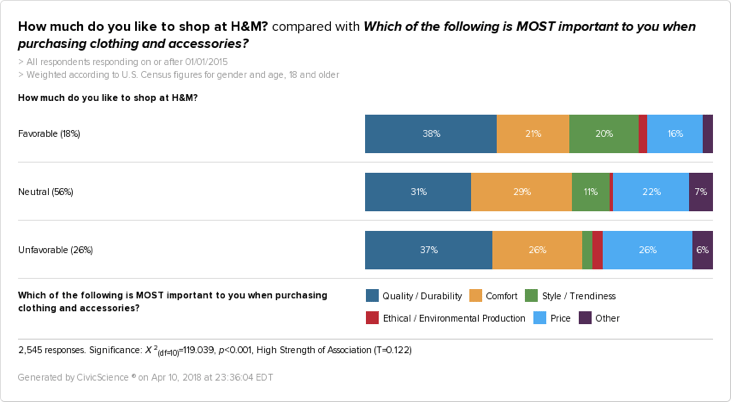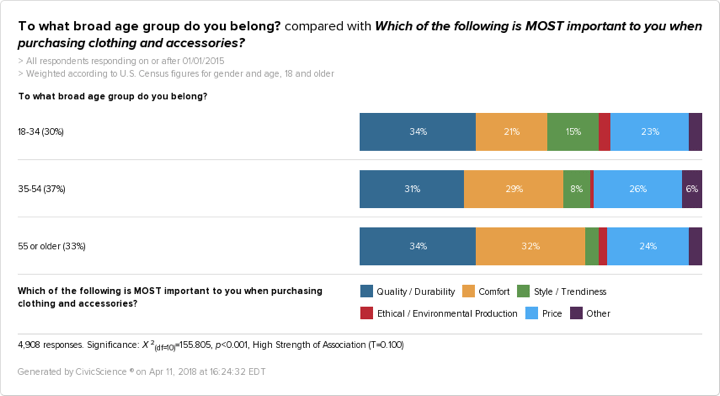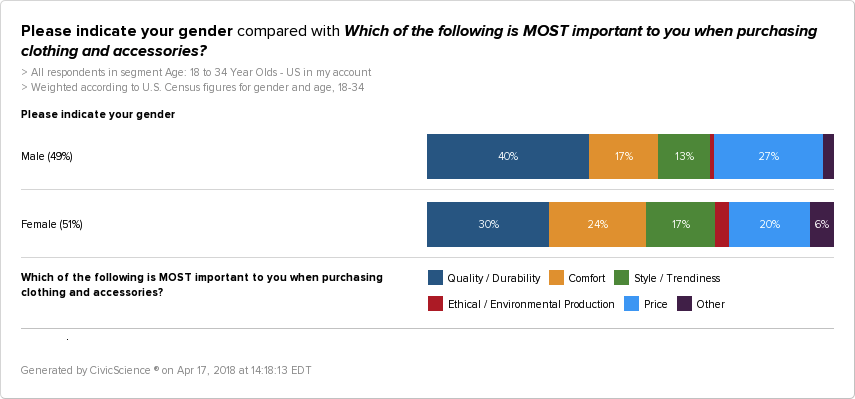The Gist: As the apparel industry grapples with changing climates, consumers are looking for quality and comfort the most when it comes to clothing and accessories.
“Clothes make the man,” Shakespeare (basically) wrote in Hamlet.
If Shakespeare came back today, he might change “clothes” to “electronic devices,” based on reports that demand for fashion is on the decline and spending on technology has now surpassed spending on apparel in the U.S. In fact, American households today spend half the amount on apparel than households did 40 years ago, culminating in what some are calling the “death of clothing.”
Indeed, the apparel industry has a lot on its plate. It’s being disrupted left and right by a growing number of trends, including online shopping, social media, changing dress code norms, fast fashion, and now, the Trump administration’s proposed Chinese trade tariffs.
But is it really the end? Is Anna Wintour’s rumored exit from Vogue an omen for the demise of fashion as we know it? By this time next year will we all be wearing unisex, utilitarian adult onesies? If so, would we really even care?
We pooled the public to get a better idea of what people are looking for these days in terms of clothing and accessories.
It turns out that U.S. adults are most interested in quality and durability and comfort when it comes to buying clothes and accessories, with quality and durability taking the lead.
Quality and Durability are important to the fashion-forward.
Given the prevalence of fast-fashion retailers that offer inexpensive yet trendy items, like H&M and Target, it’s surprising that quality and durability beat out price. Fast fashion, with its slew of “micro-seasons” and high inventory turnover rate, is not necessarily synonymous with quality and durability.
However, reports are circulating that fast fashion is not doing so well. In fact, we’ve seen a decline in H&M’s favorability since the start of 2017.
Looking more closely, we see that even those who are favorable to H&M still value quality and durability (38%) over price (16%).
Yet, H&M shoppers say that style and trendiness is more important than Target shoppers, who are more interested in comfort and price. That’s not surprising, given that H&M caters to young buyers, and young people are much more likely to be interested in style and trends than older generations.
What’s surprising is that among the very trendy and fashion-forward, quality and durability are significantly more important, even more so than style/trendiness itself:
We can see here also that comfort is most important to those who say that they are not at all impacted by fashion trends, which brings us to the next point.
Comfort: It’s not just for Baby Boomers.
Who doesn’t love a comfy pair of sneakers? Who wears them other than working out or lounging? Lots of people – in fact, we’ve seen that the comfort factor is huge with owners of running shoes, even though most aren’t runners.
As expected, it appears that the older you get, the more likely you value comfort.
And while quality and durability overall remain a constant, we can see an inverse relationship between style/trendiness and comfort emerge when looking at age.
Comfort is most important to Baby Boomers (32% compared to 21% of Millennials) while style/trendiness is the least important. Comfort is even more important than price.
The opposite is true for Millennials, who will sacrifice comfort to look on point, and put the price of clothing above comfort in terms of importance.
But ay, here’s the rub (more Hamlet) – not all Millennials. When it comes to comfort, Millennial women are actually more likely than Millennial men to put comfort over price, while still valuing style/trendiness more.
In fact, adult women as a whole say they value comfort almost as much as they value quality and durability (by 1%); on the other hand, men value quality and durability more than comfort by 10%.
In contrast to centuries of terribly uncomfortable fashion trends, a lot of ladies today just want to be comfortable. And with all the flannels, T-shirt and jeans, loafers, and yoga-chic trends to choose from, that’s not very hard to do.
Actually, that adult onesie doesn’t seem so bad after all.
Whether or not the apparel industry is headed for collapse is still uncertain, but likely someone is still going to need to clothe the American public. It seems that moving forward, they would be best to do so with quality and comfort in mind.













